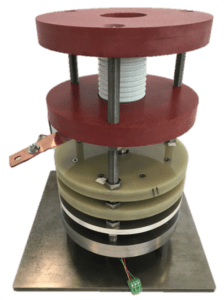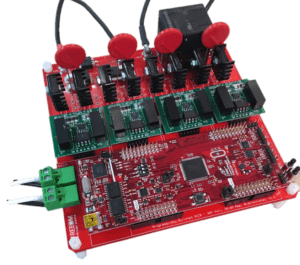Overview
Interruption of current flow in DC circuits presents new challenges over AC circuits due to the absence of a natural current zero crossing, lower system inductance, and DC systems being power converter dominated. Conventional DC circuit protection is through single blow fuses, over-sized and slow AC circuit breakers, or solid-state circuit breakers. Hybrid DC circuit breakers combine a mechanical switch and solid state switches to achieve fast operation time, but require additional complexity. Each of these approaches has limitations: high maintenance, inefficiency, cost or complexity. To increase the use of renewable energy resources connected through DC circuits, FREEDM researchers pursued several designs to improve DC circuit protection.
The Principal Investigator for this project is Dr. Iqbal Husain.
Method

The fault isolation speed of hybrid DC circuit breakers is limited by the operation speed of the fast mechanical switch (FMS). Active damping to absorb excess kinetic energy at the end of travel of the FMS enables faster actuation while maintaining a simple and rugged structure. The proposed active damping technique was optimized through transient finite element analysis and verified by experimental evaluation using a prototype Thomson Coil Actuator.
A Z-source circuit breaker forces a DC current zero crossing with an impedance network comprised of inductors and capacitors. A fault condition generates a current ripple that is traditionally interrupted at the zero crossing by a thyristor. To address efficiency and control drawbacks of this solution, FREEDM researchers replaced the thyristor with an Ultra-Fast Mechanical Switch with active damping and advanced control to allow for flexible system operation and bidirectional current flow for distributed renewable energy integration.
Advances in Silicon Carbide (SiC) devices opened new design options for solid-state circuit breakers. Using the advancements made in SiC such as low parasitic inductance, fast switching times, and low on-state resistance, a progressively switched DCCB has been developed and tested to minimize the voltage surge and current transient felt during DC fault isolation. This technique enable solid-state DC circuit breakers to be designed using smaller and more efficient components, while providing current limiting and additional protection to the grid connected voltage converters.

Results
As a result of these projects, DC circuit protection will become more reliable and affordable enabling more renewable energy resources to safely connect to the grid. The technology is being used to develop DC Microgrids to harness renewable ocean energy and can be extended to DC data centers and electric ships.
References
This research is supported by the University of North Carolina Coastal Studies Institute.
- A. Maqsood and K. Corzine. The z-source breaker for fault protection in ship power systems. In 2014 International Symposium on Power Electronics, Electrical Drives, Automation and Motion, pages 307–312, June 2014.
- C. Peng, L. Mackey, I. Husain, A. Huang, B. Lequesne, and R. Briggs. Active damping of ultra-fast mechanical switches for hybrid ac and dc circuit breakers. In 2016 IEEE Energy Conversion Congress and Exposition (ECCE), pages 1–8, Sept 2016.
- Y. Liu, X. Wei, C. Gao, and J. Cao. Topological analysis of hvdc circuit breaker with coupling transformer. In 2015 IEEE First International Conference on DC Microgrids (ICDCM), pages 129–134, June 2015.
- A. H. Chang, B. R. Sennett, A. T. Avestruz, S. B. Leeb, and J. L. Kirtley. Analysis and design of dc system protection using z-source circuit breaker. IEEE Transactions on Power Electronics, 31(2):1036–1049, Feb 2016.
- A. H. Chang, A. T. Avestruz, S. B. Leeb, and J. L. Kirtley. Design of dc system protection. In 2013 IEEE Electric Ship Technologies Symposium (ESTS), pages 500–508, April 2013.
- Invention Disclosure 16-269 Active Damping of Ultra-fast Mechanical Switches for Hybrid AC and DC Circuit Breakers
- Invention Disclosure 18-297 Voltage Stress Management of Low Voltage Solid State DC Circuit Breakers with Series Connected Semiconductors.